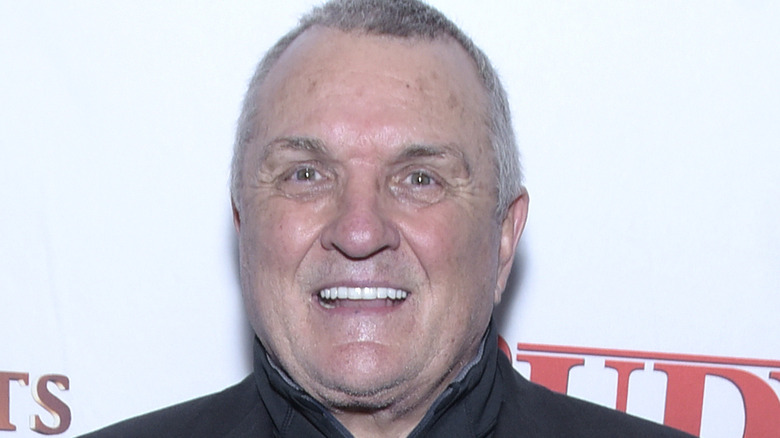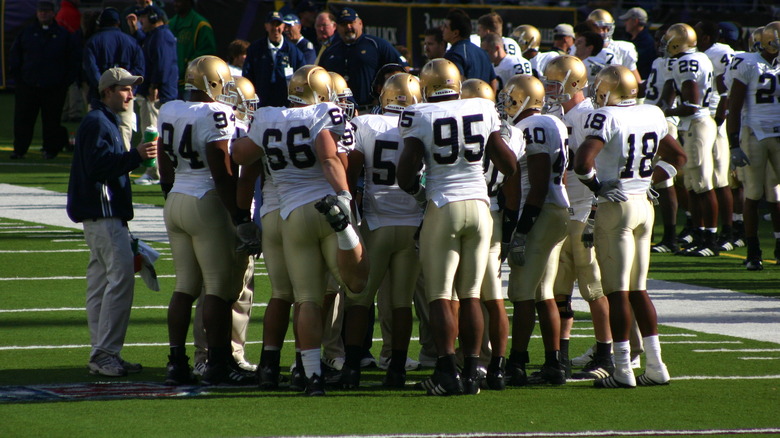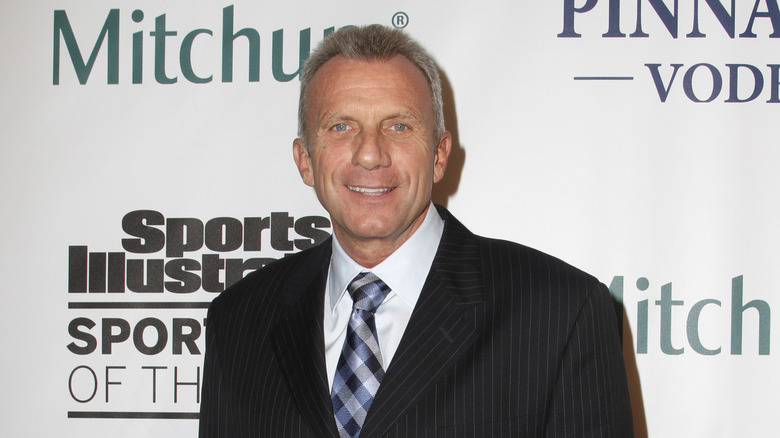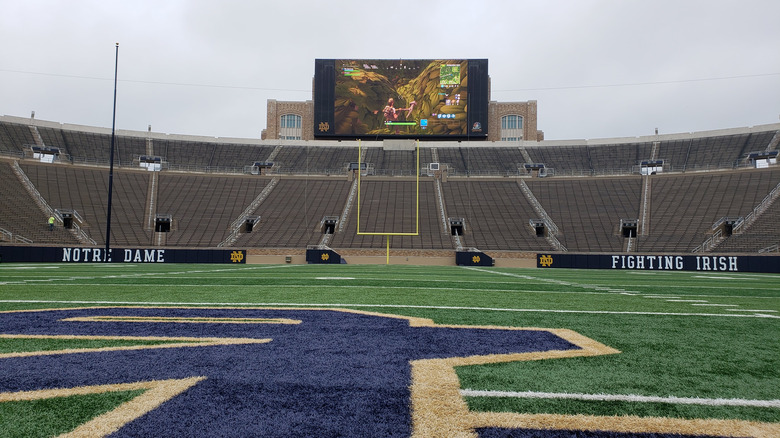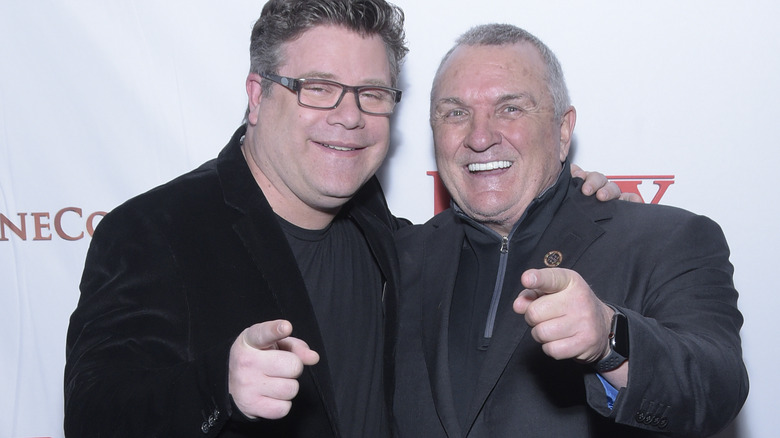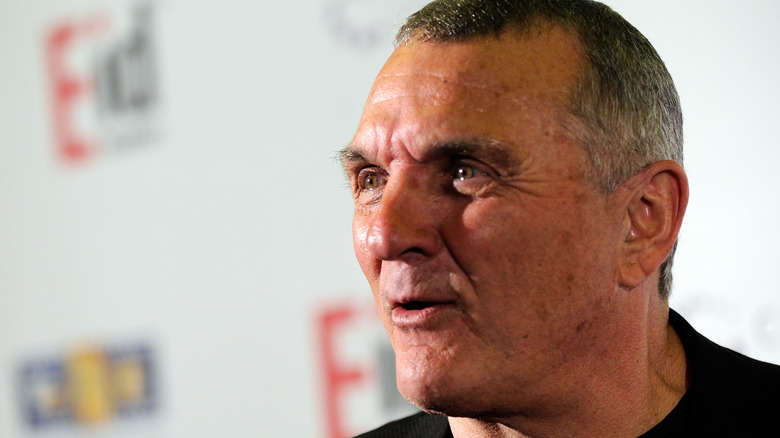How Historically Accurate Is Rudy?
While the 1993 sports drama, "Rudy," generated just under $23 million in worldwide box office, according to Box Office Mojo, the flick became a blockbuster in people's hearts. The inspiring movie revolved around Daniel "Rudy" Ruettiger's pursuit of playing on the Notre Dame football team. The third of 14 children in a lower-middle class family, Ruettiger played the sport at Joliet Catholic Academy in Illinois and even led the team in tackles during his junior and senior year. Still, at 5 foot, 6 inches and 165 pounds, a college football career seemed unlikely. "Rudy" told the "true" story of Ruettiger. It followed his journey studying at Holy Cross Junior College and working as a groundskeeper for Notre Dame Stadium as well as getting accepted to the university, making the scout team, and finally dressing for a game on November 8, 1975 — a day he was carried off the field after sacking Georgia Tech's quarterback (via Bleacher Report).
The made-for-cinema moment, captured by Sean Astin as Rudy in the film, propelled Ruettiger into a career as an author and motivational speaker, according to People, and became a beloved story to people who embraced its anything-is-possible message. "'Rudy' captured people's imagination over time was just how much heart is in the movie," explained Astin to Forbes. "This story itself, Rudy's life, the ambition that he had, his drive and his determination, he has so much heart."
But how much does the movie adhere to real life? Here's the truth behind the filmmaking.
Coach Devine wasn't a villain
A movie "based on a true story" leaves much room for fictionalizing the narrative. Yet, "Rudy," claimed Rev. William Beauchamp, former executive vice president of Notre Dame, represented Daniel Ruettiger's Notre Dame journey well. University officials, including Beauchamp, reviewed the script prior to filming to ensure its accuracy. "We didn't change much," he told The New York Times.
Some revisions to the truth became necessary to upgrade the drama, including one of "Rudy's" most powerful scenes when the Notre Dame football players, one by one, placed their jerseys on coach Dan Devine's desk to convince him that Rudy deserved to dress for the last game. The moment resonates in the film, but it's just a piece of movie-making. "There's not an iota of truth to it," said Devine to The Times. "Rudy was on the original dress list and there was never any intention to hold him out of the game. And anybody who knows me knows that if any kid came in and put his jersey on my desk, he'd never see it again."
Screenwriter Angelo Pizzo thought the changes were necessary to "capture the key truthful element and let the drama take over. This wasn't a documentary," according to another New York Times article. In fact, just relying on the truth might temper the movie's ending. Ruettiger did play on the field for 27 seconds, according to the Los Angeles Times, but not everything in the finale happened.
What really happened in the stadium
Former football quarterback for the San Francisco 49ers and the Kansas City Chiefs (via Biography), Joe Montana played on the 1975 team with Ruettiger and dismissed the movie's accuracy on the "Dan Patrick Show" in 2010, according to TMZ Sports. For example, no one chanted Rudy's name in the bleachers during the final scene when the crowd urges coach Devine to put the scrappy player on the field, Montana said. Ruettiger, though, asserted that the scene reflects reality. "Hell yeah, it happened!" Ruettiger said to ESPN. "Man, if just my family and friends alone had done it, it would have been enough, but there was a group of students who started it."
Montana also claimed that while the players hoisted Ruettiger onto their shoulders and carried him off the field, they did so more as a goof, not as a moment of triumph. "I won't say as a joke, but playing around," he told the show. Montana also seemingly takes offense to the emphasis placed on Ruettiger's impressive work ethic — something he said the entire Notre Dame squad actively pursued. "He worked his butt off to get where he was ... but not any harder than anybody else."
Real and fake characters
Joe Montana is never mentioned in the flick. Using real names required too much paperwork to obtain the releases needed, said Ruettiger to the Los Angeles Times, so the players in the film all sport monikers. Some real-life participants in Ruettiger's story, though, do appear, including Father James Riehle, who played himself as the priest in the Notre Dame locker room, and trainer John Whitmer.
Former Notre Dame defensive lineman Peter Rausch is the only actual squad member seen in the film, reported Mental Floss. He plays number 75, a team member named Steve, who begins the rallying cry of "Rudy" while standing on the field. Dressed in a blue coat with a fur collar, Ruettiger also makes a cameo in the movie as part of the stadium's audience, seated behind Ned Beatty as Rudy's father in the stands. He also visited the set daily as a consultant.
Composite characters represented experiences
Daniel Ruettiger estimated that the film was 92% accurate, reported Military. Sometimes the filmmakers did create composites to represent the people Ruettiger knew.
Occasionally, such roles also symbolized greater story arcs. For instance, Rudy never had a big brother named Frank, played by Scott Benjaminson, but in the movie, the character depicted "everybody who ever discouraged me," Ruettiger told The New York Times. The groundskeeper, Fortune, played by Charles S. Dutton, also represented the group of people that helped Ruettiger along his way, according to The New York Post. Father Cavanaugh (Robert Prosky), who assisted Rudy's academic pursuits, also was an amalgam of individuals. "There were several who played important roles, but, again, you can't develop them all in one two-hour movie," said Ruettiger to the "Pigskin Post" and quoted by Chasing the Frog. "All through my life, I would encounter people like that and they would help me get through the tough times through their wisdom and their encouragement."
Scenes that replicated real life
The movie also streamlined parts of Rudy's story, ignoring that Ruettiger enlisted in the Navy after high school and worked in a power plant (not in a steel mill as the film showed) before pursuing his Notre Dame dream, said ESPN. The death of a work friend did propel him back to school. "They were taking him away, and I was standing there, covered in his blood," said Ruettiger to ESPN. "Then I heard a voice as clear as you talking to me right now. You call it whatever you want. My gut, my conscious, God. All it said was, 'Leave.'"
The movie "Rudy" sought to re-create the feel of Ruettiger's experience, and filmed Astin reading his Notre Dame acceptance letter from the same bench the real Rudy actually sat on when he did the same. Astin also stood where Ruettiger was located on the football field. In the end, the film captures the essence of what Ruettiger went through. "It's about the journey," Ruettiger said to The New York Post. "I had to get there academically. I had to get there economically. I got beat up. How many guys would have quit along the way? You don't quit just because the odds are against you. You don't have to be an All-American. You just have to have character and courage, and I take that message very seriously."
